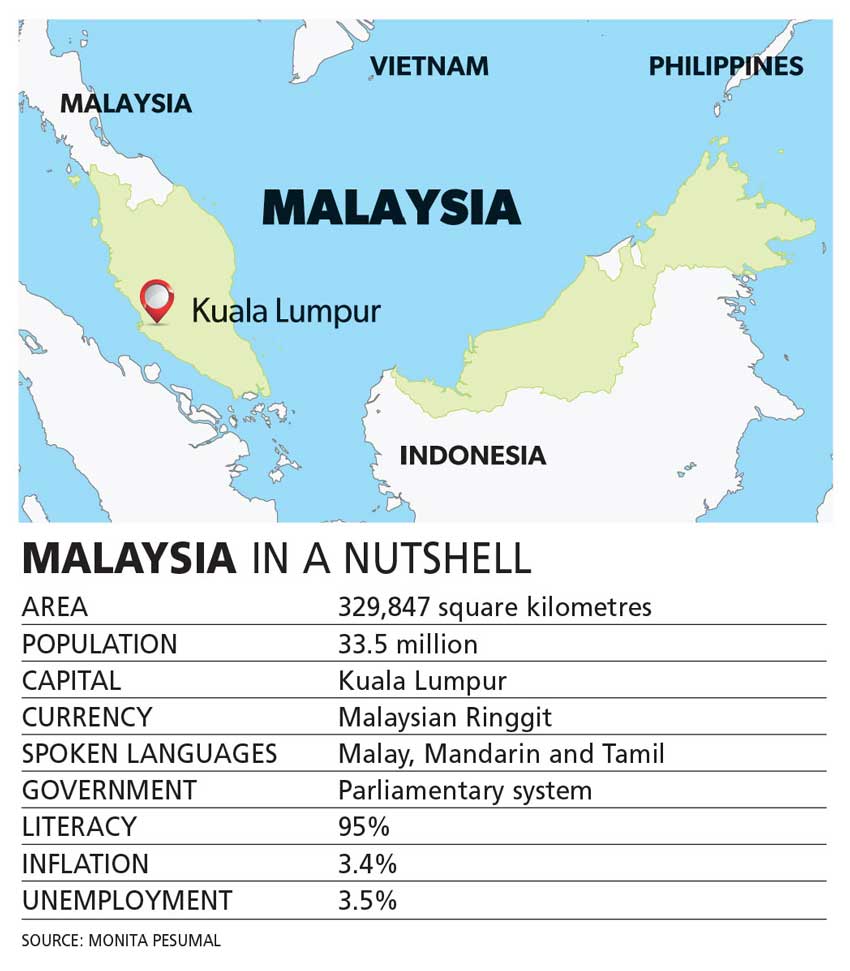MALAYSIA TODAY
MALAYSIA’S STAR IS RISING
Monita Pesumal takes a deep dive to plumb the raison d’être for a Southeast Asian success story

According to the BBC, Malaysia boasts “one of Southeast Asia’s most vibrant economies, the fruit of decades of industrial growth and political stability.”
Today, Malaysia is the world’s 38th largest economy. The country’s success comes from having diversified its homegrown economy from a humble farming state to a modern industrialised nation.
Initially dependent on agriculture and commodity-based output, it now prides itself on having robust manufacturing and service sectors, which have propelled the country forward to become a leading exporter of electrical appliances, parts and components.
Manufacturing underwent rapid expansion from the 1970s; and by the early 21st century, it became the backbone of Malaysia’s economic growth. The sector constitutes nearly a third of the country’s GDP, and employs more of the workforce than all primary activities of agriculture and mining combined. This transformation was aided by political stability under the dynamic leadership of former prime minister Dr. Mahathir Mohamad.
Malaysia is among the world’s largest producers of electronic equipment, chemicals, palm oil, wooden products, rubber and textiles. And its natural resources include an abundance of minerals such as tin, copper, iron ore, bauxite, timber, petroleum and natural gas.
In April, the government expressed disappointment over an EU law that bans the import of commodities linked to deforestation, fearing a hit to its exports of palm oil. The European Parliament approved a landmark law that requires companies that sell to the EU to produce ‘verifiable information’ affirming that their goods were not grown on land deforested after 2020 – or risk being fined.
The law will apply to soya, beef, palm oil, wood, cocoa, coffee, rubber, charcoal and derived products – including leather, chocolate and furniture. Malaysia is the world’s second largest exporter of palm oil.
Together with nine other members of the Association of Southeast Asian Nations (ASEAN), Malaysia established the ASEAN Economic Community (AEC) in 2015 with the aim of advancing regional economic integration.
It is the European Union’s third largest trade partner, and the latter is the chief investor in ASEAN countries. In the coming decade, the association is set to grow in importance with an annual projected growth of between four and five percent, making it one of the fastest growing regions in the world.
The country also exports petroleum and natural gas, and is one of the world’s largest sources of commercial hardwoods. Trade and investment have been instrumental in job creation and income growth with export activities generating about 40 percent of employment opportunities.
This has resulted in Malaysia having averaged decades of annual GDP growth and enjoying one of the most open economies in the world.
In February, Bloomberg reported that Malaysia grew at its quickest pace in more than two decades last year as pent-up demand helped the nation grab the coveted title of the fastest growing economy in Asia.
While China’s economy grew by three percent and Vietnam’s by eight percent, Malaysia’s leapfrogged by nine percent.
In his budget speech early this year, Prime Minister Anwar Ibrahim expressed optimism that the nation’s economy will achieve higher than anticipated growth of 4.5 percent in 2023.
The World Bank states that Malaysia’s trade to GDP ratio has averaged over 130 percent since 2010. Though the pandemic had a major impact on Malaysia, the country is expected to achieve its transition to a high income economy by next year.
Although it’s gradually declining, income inequality in Malaysia remains high relative to other Southeast Asian countries and this is a cause for concern. In fact, Ibrahim has pledged to “end extreme poverty” with a government allocation of US$ 169 million to upskill workers under a pilot programme dubbed the ‘People’s Income Initiative.’
Furthermore, the Household Income and Basic Amenities Survey Report 2020 conducted by the Department of Statistics Malaysia revealed that 20 percent of households from the M40 group fell into the B40 cluster as a result of the pandemic. The M40 constitutes Malaysia’s middle class while B40 represents bottom tier households that have an income below Malaysian Ringgit 4,850.
Pre-COVID-19 statistics indicate that Malaysia was the fourth most visited country in the Asia-Pacific region after China, Thailand and Japan. Normally, about 26 million people visit the country annually to enjoy its lush rainforests, sandy beaches, rich and diverse culture, colourful festivals, ancient tribal heritage, and vibrant areas such as Kuala Lumpur, George Town, Penang, Malacca and Langkawi.
After enduring restrictions due to the pandemic, Malaysia is finally ready to welcome tourists. It is set to host up to 9.6 million guests this year, compared to the original estimate of 2.5 million. Though this is far less than pre-pandemic levels, it’s still a win for Malaysian tourism in spite of the rising incidence of COVID-19.
Though the pandemic had a major impact on Malaysia, the country is expected to achieve its transition to a high income economy by next year





